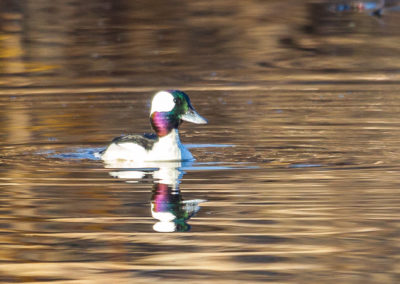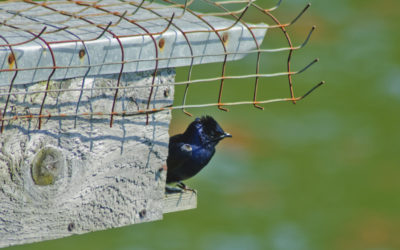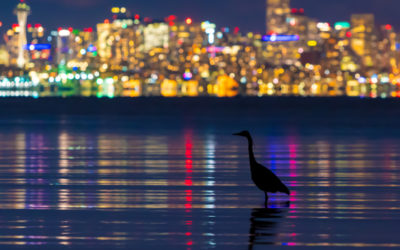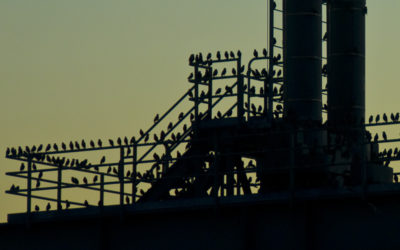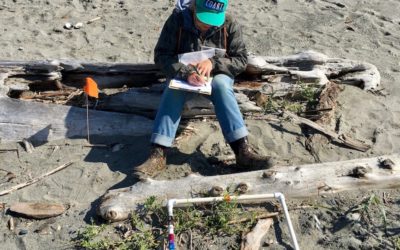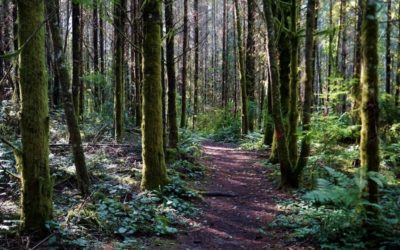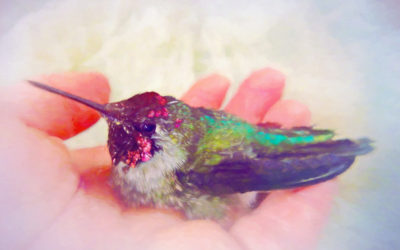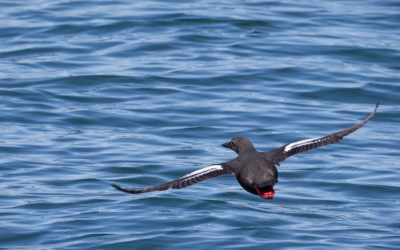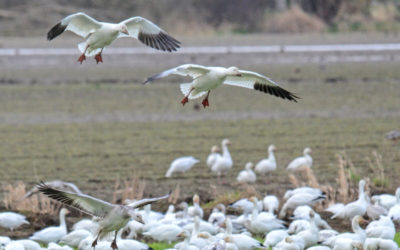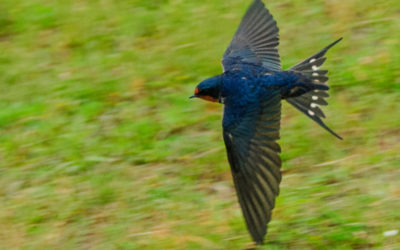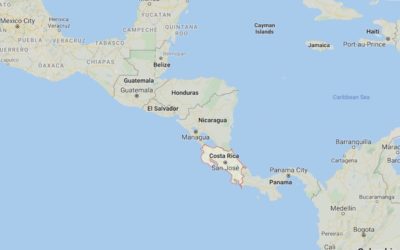THE BIRDS OF BUFFLEHEAD POND FARM
by Adelia Ritchie, Winter 2019
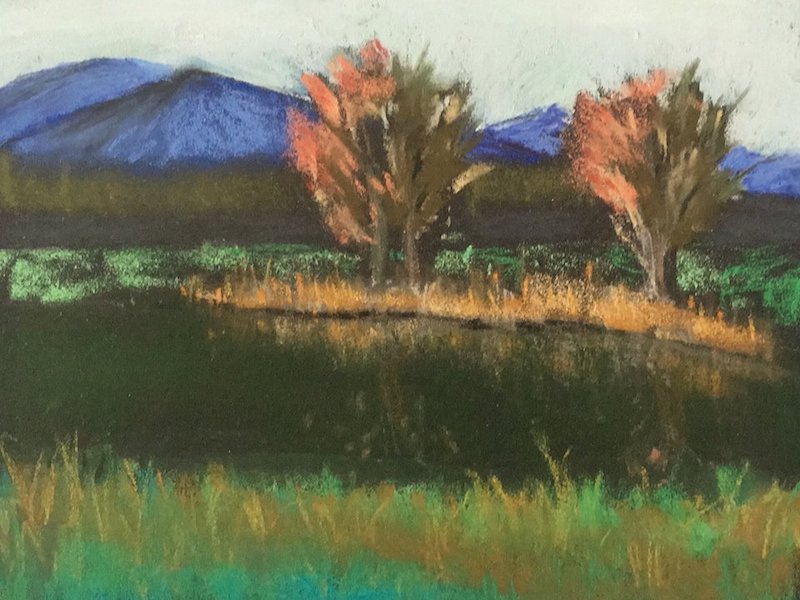
Painting by Adelia Ritchie
THE BIRDS OF BUFFLEHEAD POND FARM
by Adelia Ritchie, Winter 2019
Such big ideas we had when we first set out to inhabit Bufflehead Pond Farm! The place had not been properly tended for years and the local ecology (mostly blackberries and stinging nettles) had taken control of the landscape. Being human and with engineering and military backgrounds, both of us had compelling urges to clean up, organize, remove deadfall and ugly trees, spray weed killer everywhere, hack, chop, and rototill. Cleaned up, cleared, organized, easy to manage was our goal. But what unfolded from there is the story about how we discovered our new farm family and their relationships to each other and to all the things that grow in and around the pond.
The pond, named for its winter bufflehead ducks and its summertime mallards and wood ducks, was one of the biggest offenders initially. If only we could clear out those tall reeds that threaten to choke the pond, and those nasty lily pads that seem to be spreading! OUT with them! Oh, and that huge weedy tree at the edge of the pond that blocks our long view of the stables and beyond. Chop it down!
Fortunately for us former city slickers, we took the time to observe and learn. We can keep an eye on the pond from every room in the house, and we keep the binoculars and the bird identification books handy at all times, just for this purpose. After a time, we began to learn the habits and personalities of our pond birds and started to give them names.

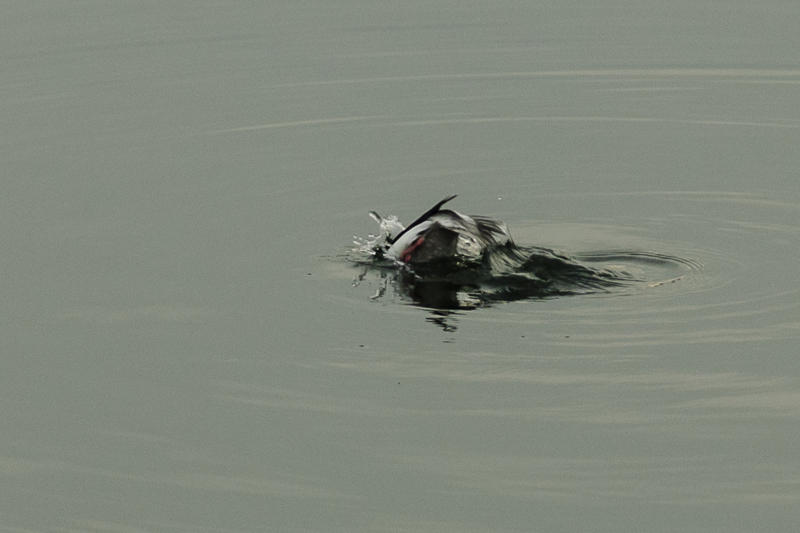

Photos by John F. Williams
First, I‘d like to introduce the two major players on the stage of Bufflehead Pond, primarily the bufflehead ducks. We love these little fellows for their happy diving ways, their sweet dispositions, and (let’s face it) they are just too darned cute for words.
“Mr. Buffle” is the main character on the winter pond and he arrives each year in mid-November. He believes this is his pond, and although he’s quite agreeable about sharing it with other bufflehead ducks and the occasional mallard visitor, there was no question in any of their minds about who was boss. To indicate his ownership, he positions himself in the exact center of the pond and grooms himself, a very ostentatious and commanding display. No one challenges him. Sadly, we never saw him with a female all last winter, except for a small flock of hooded mergansers (cousins of buffleheads), with whose females he flirted shamelessly, chasing them into the reeds for who knows what nefarious activities.

Photo by John F. Williams
Observing all this from his perch in the reed patch close to shore is the boldly colored red-winged blackbird, a dominant male who has been here the entire time we have—summer, fall, winter, and spring—watching, waiting, keeping an eye on things. Last fall, a large family (perhaps 25-30) of these birds gathered in the tall nesting reeds close to shore each morning for a group pep talk and gossip session, meeting there again each evening to share their full reports. They often congregated in the big ugly weedy-looking tree (the one we decided not to chop down) that grows on the edge of the pond close to the reeds. There were times when the noise from the Blackbird Happy Hour each day was deafening, but always happy-sounding. Last fall all of them disappeared on their winter migration, all except for the “Daddy Redwing,” who still hangs out in the reeds every day and keeps his eyes on all the activities in and around the pond. Where Mr. Buffle manages the water and the feeding grounds within, Mr. Redwing manages the space around and above the pond.

Photo by Lee Tenneboe
These are the two main characters at Bufflehead Pond Farm, the two bad boys who keep everything functioning smoothly and well balanced. We think of Mr. Buffle as the President, and Mr. Redwing as the CEO. The other day there was a very interesting collection of ducks paddling about, not all in agreement about who gets to occupy and feed in which section of the pond. And I swear I am not making this up: Mr. Redwing left his observation perch in his tree and flew down, landed on a lily pad near the offending ducks to have a stern conversation with them on their level, and then returned to his reed perch, satisfied that the argument was resolved.

Photo by John F. Williams
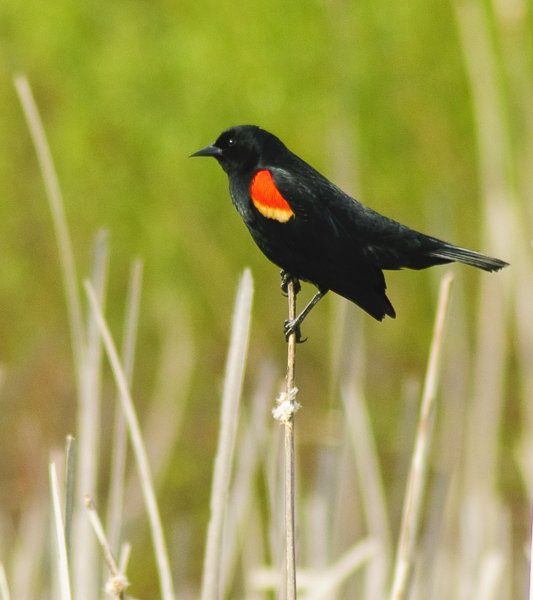
Photo by John F. Williams
Observing this, amazed at this “CEO Bird,” I realized that it’s not really Mr. Buffle’s pond after all. It undoubtedly belongs to Mr. Redwing. And to prove the point, when a young eagle came to hunt last summer, this bold little bird attacked it and chased it away. Afterward, I did notice his chest seemed a bit more puffed out than usual.

Photo by Lee Tenneboe
Another of our pond residents is the great blue heron, Mr. Blue, who hangs out at the edge of the pond in magnificent stillness awaiting an unsuspecting frog or minnow for dinner.
 You can learn more about the great blue heron in the article with the unlikely title The Great Blue Heron, in this issue.
You can learn more about the great blue heron in the article with the unlikely title The Great Blue Heron, in this issue.
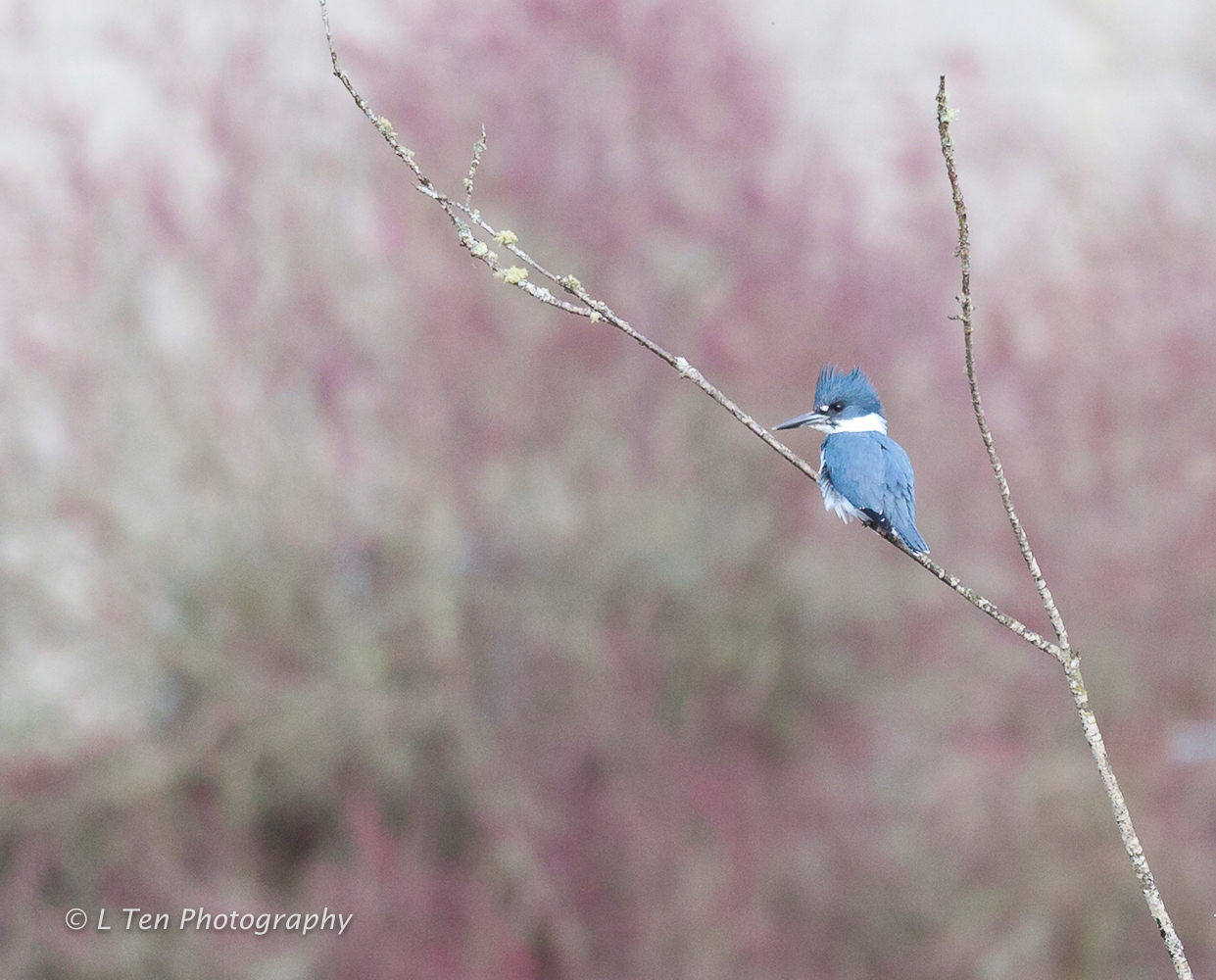
Photo by Lee Tenneboe
Photo by Lee Tenneboe
Our noisiest pond bird is the kingfisher (we call him “Eddie Kingfisher”) who chatters like a chainsaw to announce his arrival, as he dives repeatedly until he nabs a tiny fish. He’s a patient hunter, like the great blue heron, sitting for hours high in a tree at the edge of the pond, watching, waiting, then swooping down for the catch.
A bald eagle occasionally visits to hunt on the pond, which is flanked on one side by a forest of western cedars and Douglas firs where he can perch at 200 feet altitude on a bare limb. Unfortunately for the heron, eagles have to eat too, and Mr. Blue lost the aerial dogfight last summer and became food for eagle nestlings.

Photo by Lee Tenneboe
Shortly after that sad event, we had a charming unexpected visitor live on the pond for months. Quirky the cormorant was a youngster who wasn’t clear yet about his identity or where he belonged, but we gave him full credit for trying. He did his best to make friends with the Canada geese, named Nicolas and Isabel, and his antics made us laugh out loud. After a quick dive to find dinner, he would stand on the dock with his wings spread to dry, bobbing his head up and down in a display of sheer joy. Even so, none of the ducks wanted to socialize with him, the geese ignored him, and he finally moved on, back to his more proper habitat by a larger body of water.

Photo by Lee Tenneboe

Photo by Adelia Ritchie

Paintings by Nancy Sefton
Autumn is a season for bird migrations! Dropping in, hanging out, or passing over, we see lots and lots of wonderful birds. It helps that the pasture grass is short and that the rain garden doesn’t drain properly, as both these effects attract both bug- and seed-eaters to our view.
For just one example, October brings flocks of northern flickers to the fields, where they search for worms and insects. If you hear an occasional rat-a-tat under your eaves this time of year, it could be the flickers cleaning out the spider population for you. We welcome that friendly noise!

Meanwhile, we await the return of our most beloved denizens, the bufflehead ducks. Mr. Buffle returns to the pond for the winter, sometimes with his mate, usually showing up around mid-November each year.
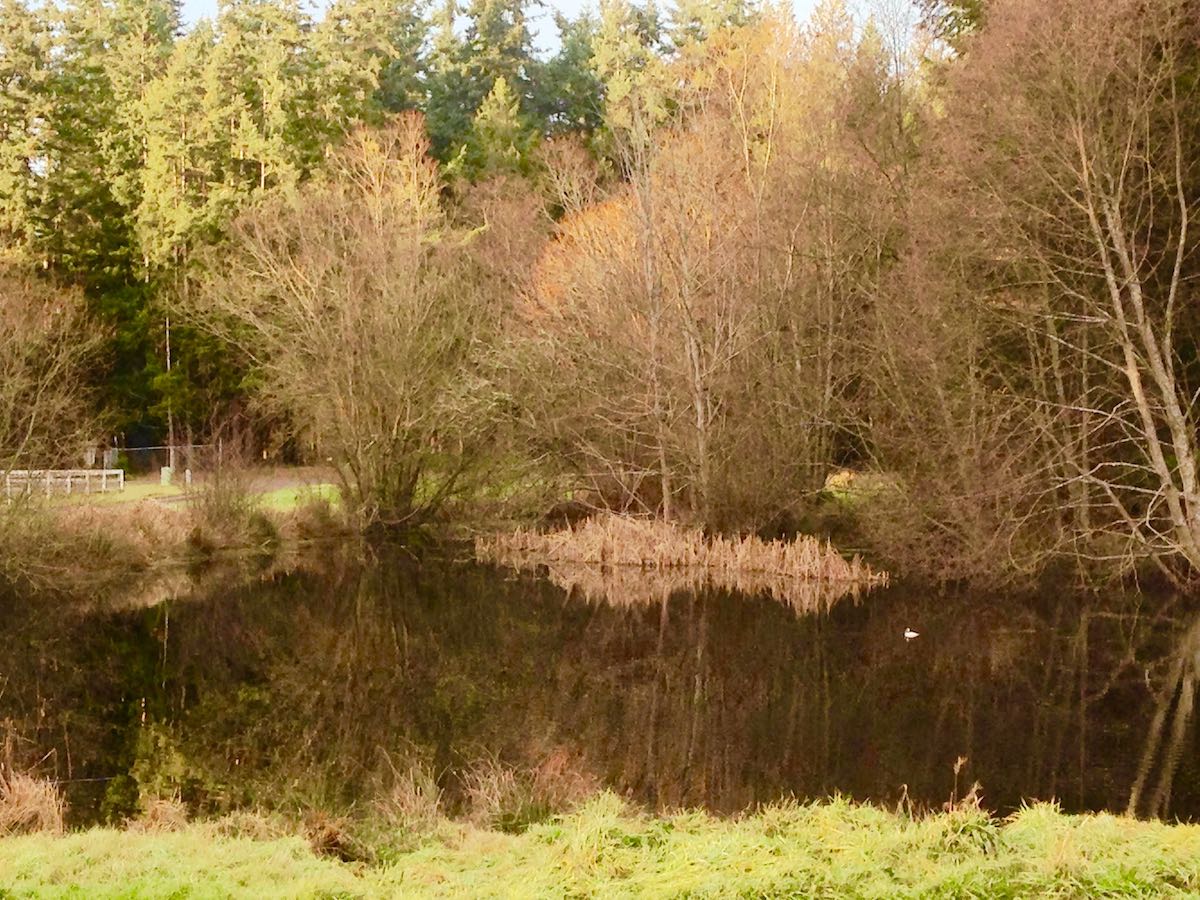
Photo by Adelia Ritchie
The reeds and lily pads and ugly trees, the bugs, slugs and grubs, all will have to stay, bottom line. We no longer use pesticides nor herbicides, and we allow native reeds and scrubby waterline trees to stay where they belong. If there were no insects and seeds to eat, no safe places to nest or hide or feed, there would be no birds at Bufflehead Pond Farm. If the pond were full of chemicals, there might not be healthful meals for the pond birds. Now that we understand the relationships and connections of our tiny ecosystem, we have adopted a different way of thinking and living that not only allows a wide variety of avian life to exist here, it encourages them to stay and breed and live out their delightful lives.
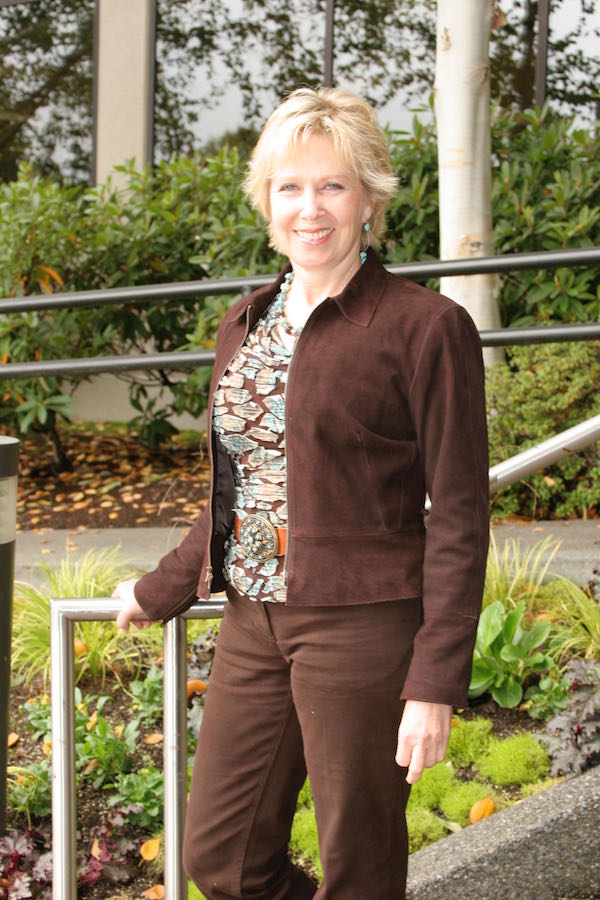
Adelia Ritchie grew up on a northern Virginia farm, with horses, cattle, dogs, and her pet pig Porky, who ran the whole show. A long-time resident of the great Pacific Northwest, Adelia is a serial entrepreneur, scientist, educator, and artist. She received a B.S. in Chemistry and Physics from the University of West Florida, and an M.S. and Ph.D. in Physical Organic Chemistry from Northwestern University. In June 2017, she completed the Climate Reality Leadership training program under the Hon. Al Gore, and currently works with educators, organizers and strategists to promote a deeper understanding of the science of climate change and its impacts on the complex ecological web of life. Adelia resides in Hansville, WA, with her garden, her dogs and a flock of very entertaining chickens.
Table of Contents, Issue #6, Winter 2019
Purple Martins
by Gene Bullock, Winter 2019Photo by John F. WilliamsPhoto by John F. Williamsby Gene Bullock, Winter 2019 Native Americans learned long ago that if they hung hollow gourds around their villages, they could attract Martins to nest in them. The birds repaid them by...
Great Blue Heron
by Nancy Sefton, Winter 2019Photo by Philip HutchersonPhoto by Philip Hutchersonby Nancy Sefton, Winter 2019 As I floated in my kayak, I spotted a great blue heron perched on a mass of partially submerged roots. Suddenly it stabbed the water and came up with a small...
Poems-6
Winter 2019Winter 2019 Haiku by Nancy Rekow One heron standing.Mist hangs low in the valley.I will write to you.Painting by Kathleen Faulknerby Nancy TaylorIn Beacon Hill Park, Victoria B.C. I watch a bald eaglelight...
Citizen Science
by Todd Ramsey, Winter 2019Photo by Eric Wagner, COASST staffPhoto by Eric Wagner, COASST staffby Todd Ramsey, Winter 2019 It all started out so innocently. We just wanted to pick up trash on the beach after a storm. Soon after that we discovered COASST.org (Coastal...
Foto Tour 2
Showcase of Participant Photos North Kitsap Heritage Park from September 18, 2019 Showcase of Participant Photos North Kitsap Heritage Park from September 18, 2019 On September 18, 2019, WSU Extension in Kitsap County hosted a Forest Foto Expedition led by John F....
Should I Stay?
by Sharon Pegany, Winter 2019Artwork by Catherine WhalenArtwork by Catherine Whalenby Sharon Pegany, Winter 2019 turn of time rustle of feather echoing songs of beak and bill listen afresh to the voices among usWinter may be a quiet season in the Salish Sea region,...
Seabirds Are Cool
by Julia Parrish, Winter 2019Photo by Lee TenneboePhoto by Lee Tenneboeby Julia Parrish, Winter 2019 In Washington State, there is a bewildering abundance of seabirds. The seabirds of the surf zone that always capture my imagination are in the Alcid family: murres,...
The Russians Are Coming
by Paul Pegany, Winter 2019Photo by Catherine WhalenPhoto by Catherine Whalenby Paul Pegany, Winter 2019 The Russians are indeed coming! They are winged, white, and ready to spend their winter along the shores of the Salish Sea in northwest Washington. As the rain...
Barn Swallow
Nature's Pest Control by Adelia Ritchie, Winter 2019 Photos by John F. Williams except where notedNature's Pest Control by Adelia Ritchie, Winter 2019 Photos by John F. Williams except where notedClose cousin of the purple martin is our hard-working summertime...
Editorial-6
by Adelia Ritchie, Winter 2019by Adelia Ritchie, Winter 2019 On vacation in Costa Rica recently, I walked the city of San José one morning and visited a famous museum of pre-Colombian civilization, back when indigenous tribes lived in harmony with nature and as a...
PLEASE HELP SUPPORT
SALISH MAGAZINE
DONATE
Salish Magazine contains no advertising and is free. Your donation is one big way you can help us inspire people with stories about things that they can see outdoors in our Salish Sea region.
We also don't advertise Salish Magazine, so please spread the word of this online resource to your friends and colleagues.
Thanks so much for your interest and your support.
We also don't advertise Salish Magazine, so please spread the word of this online resource to your friends and colleagues.
Thanks so much for your interest and your support.


